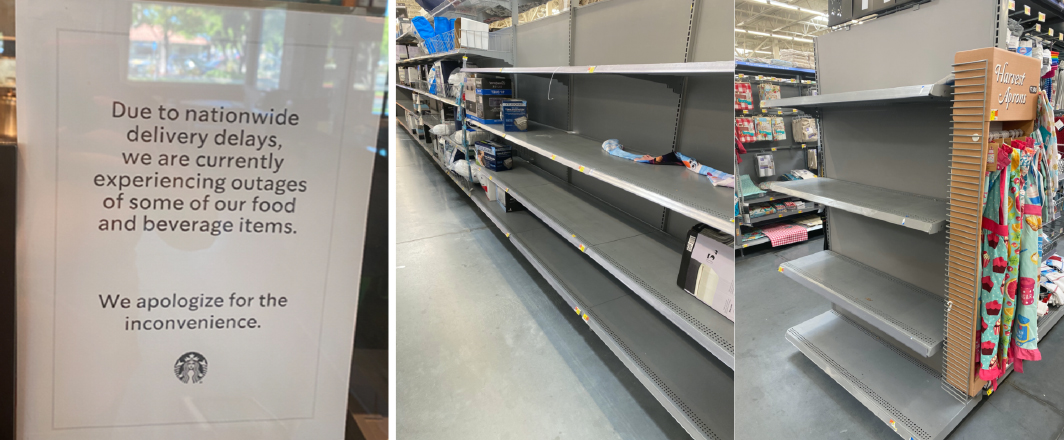
DIpil Das
What’s the Story?
Wide swings in consumer demand and external supply chain issues have resulted in a lack of key items on store shelves, hurting consumer sentiment as well as retailer revenues and profitability. Demand forecasting software can help retailers manage inventory and other operational functions to keep pace with demand shifts. We discuss the retail industry’s current need for demand forecasting solutions and present a notable provider of such software, Impact Analytics—a Coresight Research Innovators client.Why It Matters
Keeping goods on the shelf is imperative for retailers—since they cannot generate revenues and profits for goods they do not sell—but also because of the significant impact in-store availability has on current and future customer satisfaction. If a consumer leaves the store due to a product not being in stock, the customer may never return and may share their experience with friends and social media followers, which can have a multiplier effect on damage to future revenues.Demand Forecasting Software: In Detail
Demand forecasting has become essential, not least due to wide demand swings amid the Covid-19 pandemic, which we discuss below. Demand forecasting supports retailers in anticipating and adapting to such consumer shifts. Current Retail Environment Plagued by Continuing Swings in Consumer Demand Retailers and their supply chains are experiencing a tough couple of years. At the outset of the pandemic, consumers dramatically increased their purchases of health and nonfood grocery products such as paper towels and cleaning products, as well as food at home, home and home-improvement products, and electronics devices—for working, exercising, enjoying entertainment and generally spending more time at home during lockdowns. This volatility in demand upended supply chains, representing one of the drivers of the current global chip shortage. Now, many consumers are feeling more confident to travel and visit restaurants again (see our US Consumer Tracker for our survey findings that demonstrate this return to pre-pandemic behavior in the US), and companies are in the early stages of recalling workers back to offices. Inflexible supply chains and shipping bottlenecks are thus being exacerbated by renewed demand shifts, causing inventory shortages in the retail and foodservice industries, as shown by the images below. [caption id="attachment_129536" align="aligncenter" width="725"] Source: Coresight Research[/caption]
Demand Forecasting Platforms
Demand forecasting supports retailers in anticipating and adapting to consumer shifts. It occupies the center of a retailer’s operations, interconnecting inventory, pricing and financials, as illustrated in Figure 1.
Source: Coresight Research[/caption]
Demand Forecasting Platforms
Demand forecasting supports retailers in anticipating and adapting to consumer shifts. It occupies the center of a retailer’s operations, interconnecting inventory, pricing and financials, as illustrated in Figure 1.
Figure 1. Interconnectedness of Demand Forecasting, Operations and Financials [caption id="attachment_129537" align="aligncenter" width="724"]
 Source: Coresight Research[/caption]
Intelligent demand forecasting uses artificial intelligence (AI)/machine learning (ML) to generate insights and predictions. The accuracy of demand forecasting platforms is increased through the incorporation of external data in addition to internal data—such as weather forecasts and local calendars of events. The retail environment and broader economic context should also be taken into account to improve forecasting accuracy: For example, consumer migration patterns and infection figures have also proved extremely helpful for many retailers in anticipating local demand shifts amid the Covid-19 pandemic.
Source: Coresight Research[/caption]
Intelligent demand forecasting uses artificial intelligence (AI)/machine learning (ML) to generate insights and predictions. The accuracy of demand forecasting platforms is increased through the incorporation of external data in addition to internal data—such as weather forecasts and local calendars of events. The retail environment and broader economic context should also be taken into account to improve forecasting accuracy: For example, consumer migration patterns and infection figures have also proved extremely helpful for many retailers in anticipating local demand shifts amid the Covid-19 pandemic.
- For more on demand forecasting in the supply chain, read our separate deep dive.
- Forecasting, replenishment and allocation
- Unified price, promotion and markdown optimization
- Merchandise and assortment planning
- AllocateSmart, which improves allocation precision via a dashboard, leveraging AI for the automation of store groups and product profiles, and through determining an allocation strategy and final allocation
- AttributeSmart, which uses AI to create product attributes from image or text to improve assortment decisions and online shopping experiences
- AssortSmart, which optimizes assortment breadth and depth and creates localized channel and store assortments
- PriceSmart, which optimizes, automates and simplifies the pricing process
What We Think
Demand forecasting is essential for maintaining customer satisfaction through keeping shelves stocked and preventing walkouts. It also has major implications for inventory, assortment, pricing and, therefore, revenues and margins. Adding external data such as weather, local calendars and consumer sentiment markedly improves the accuracy of demand forecasting. Implications for Brands/Retailers- Retailers practicing intelligent demand forecasting will gain a competitive advantage in customer sentiment through having desired products on the shelf. This raises revenues and margins, enabling a retailer to invest in its stores or future technologies.
- Retailers managing inventory efficiently will likely require less inventory and warehouse space.
- There are multiple types of demand forecasting platforms, for enterprise software companies and innovators.
- AI and ML are key technologies powering demand forecasting, and the technology continues to evolve at a rapid pace, creating opportunities in retail.
- There also opportunities to develop solutions for specific retail segments, such as grocery, which requires the management of a much larger number of SKUs (stock-keeping units) than in other sectors.